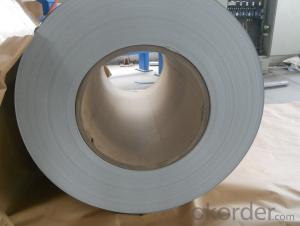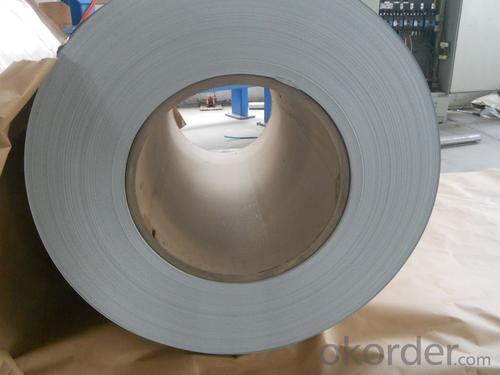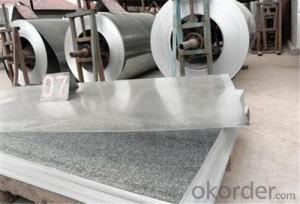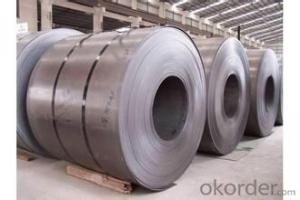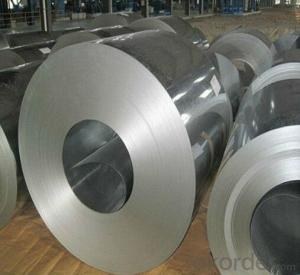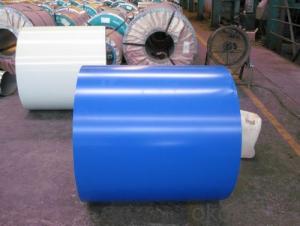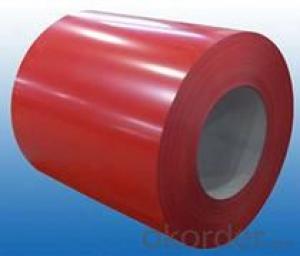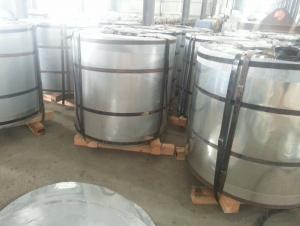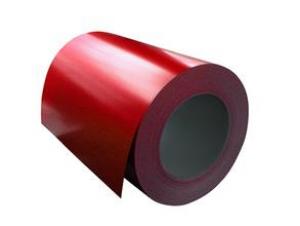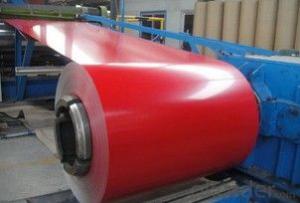PRE- PAINTED GALVANIZED STEEL COILS
- Loading Port:
- Tianjin
- Payment Terms:
- TT OR LC
- Min Order Qty:
- 50 m.t.
- Supply Capability:
- 5000 m.t./month
OKorder Service Pledge
OKorder Financial Service
You Might Also Like
PRE-PAINTED GALVANIZED STEEL COILS
As per JIS G3322 CGLCC, ASTM A755,GB/T 12754, EN 10169 DX51D+AZ,
commercial quality or Lock forming quality (LFQ), AZ coating:50 g/m2 to 180 g/m2,
Top surface : 15 - 20 micron polyester + 5 micron primer ,
Back surface: 5 - 7 micron, or 7-8 micron polyester + 5 micron primer. Color: According to RAL Card or Clients' requests. Coil Weight max. 12 MT, Coil ID:508mm/610mm.
With or without protective film on the top side.
Categories of paint: polyester/silicon modified polyester (SMP)/PVDF
Thickness: 0.18-1.20mm
Width: 700-1250mm
Minimum order: 50MT per size
Product Feature:highly tensile, strong color fastness, good rainproof performance, continuous rolling, good corrosion resistance, easy installment and construction, easily removable, low cost
Inside:doo,doorcase,light steel roof structure,vent gutter,etc
Electial Appliance:refrigetator.washer,switch cabinet,etc
Furniture:central heating slice,lampshade,etc
Other :clapboard,container, writing panel,garbage can,timekeeper,etc
- Q: If you combine stainless steel with gold, does that make stainless gold?
- Stainless steel, I believe, was an actual trade name of a british cutlery company's knives, once the ability to create iron-chromium alloys was mastered. Stainless steel's main alloying agent that prevents it from rusting, is Chromium. The Chromium in the steel creates an protective layer (not unlike rust), which acts as a protectant for the rust-prone iron...keeping real rust away. I am no metallurgist, but I have not heard of gold being used as an alloying agent in common steels. I'm not even sure they would mix. Not all metals can be stirred together successfully. Even if gold could be used as an alloying agent for steel, it would need to be in such a small percentage, you would not end up with a metal that was gold in appearance...so it would still look like steel of some sort. The funny part is, gold is already stainless, and does not tarnish or rust as it is.
- Q: Is steel framing eco friendly? Why or why not.
- No because unlike the timber in trees, it is not a renewable resource and takes much heat energy to produce.
- Q: What is the process of pickling and oiling steel coils?
- The process of pickling and oiling steel coils involves several steps to ensure the quality and protection of the steel. Firstly, pickling is the process of removing impurities and scale from the surface of the steel coil. This is typically done by immersing the coil in an acid bath, such as hydrochloric acid or sulfuric acid, which helps to dissolve any oxides, rust, or other contaminants present on the surface. This step is crucial as it prepares the steel for further processing and prevents any potential defects or corrosion. After pickling, the steel coils are rinsed with water to remove any residual acid and then dried. Once the coils are clean and dry, they are then coated with a layer of oil to provide temporary corrosion protection and lubrication during subsequent handling and transport. The oil coating helps to prevent the steel from rusting or oxidizing before it is further processed or used in various applications. The oiling process can be done in several ways. One common method is by applying the oil using a roller or brush, ensuring that the entire surface of the coil is evenly coated. Alternatively, the coils can be passed through a bath or spray chamber where the oil is applied. The type of oil used can vary depending on the specific requirements of the steel and its intended use. Some common oils include mineral oil, synthetic oils, or specialized rust-preventive coatings. Once the oiling process is complete, the steel coils are typically stacked, wrapped, or packaged for storage or transportation. It is important to handle the coils carefully to avoid damaging the oil coating and compromising the corrosion protection. Overall, pickling and oiling steel coils are essential steps in the steel manufacturing process to ensure the quality, cleanliness, and protection of the steel, ultimately extending its lifespan and enhancing its performance in various applications.
- Q: ok I got a dpms ar 15 and all i have put though it is good brass 223 ammo but is it ok to shoot the old crappy steel cased wolf ammo out of it will it hurt its function or will it hurt it cosmetically?
- I won't run steel through my Ar-15,why spend $700-$1200 on a rifle to run some cheap steel case **** in it? That is what an ak or sks is for.
- Q: Steel is a mixture of Iron Carbon . So , is steel a metal or non - metal ?
- This Site Might Help You. RE: Is Steel a Metal or Non - Metal ? Steel is a mixture of Iron Carbon . So , is steel a metal or non - metal ?
- Q: How are steel coils used in the production of industrial machinery?
- Steel coils are used in the production of industrial machinery as they provide a strong and durable material for various components. These coils are often shaped and cut to specific sizes to create parts such as gears, shafts, and frames, which are essential for the functioning of machinery. The high strength and flexibility of steel coils make them ideal for withstanding heavy loads and harsh operating conditions, ensuring the reliability and longevity of industrial machinery.
- Q: I am thinking of buying a stainless steel necklace, but I need to know if it will discolor. My brothers ring turned brown, but he forgot what kind of metal it was. Also answer if I can wear it in the shower because I wear my other necklace in it.
- First check if the Stainless Steel is solid or just some base metal plated with SS. SS has many SAE steel grades(304,316,316L,etc) but in general most will not rust if you do not immerse in sea/salt water over long period. Some can tone to grey over time but IMO that will only add more aesthetic value to the necklace. Yes, you can shower wearing SS because sometimes I also do that wearing my SS dive watches.
- Q: How are steel coils used in the manufacturing of automotive accessories?
- Due to their strength, durability, and versatility, steel coils find widespread use in the manufacturing of automotive accessories. These coils act as the primary raw material for various components and parts utilized in the automotive industry. One notable application of steel coils in automotive accessory production involves the creation of body panels and frames. These coils are shaped and formed according to desired specifications, and subsequently undergo cutting, stamping, and welding processes to fabricate the body panels and frames of vehicles. The exceptional strength of steel coils ensures that the resulting body panels and frames possess the necessary robustness to endure daily use and provide structural integrity to the vehicles. Moreover, steel coils are also employed in the production of automotive suspension systems. Specifically, coil springs, which constitute integral elements of the suspension system, are commonly fashioned from steel coils due to their capability to absorb and distribute the weight and impact of the vehicle. By supplying essential support and shock absorption, these coil springs contribute to a smooth and comfortable ride. Furthermore, steel coils are utilized in the manufacturing of various automotive accessories like exhaust systems, brackets, and other components. These coils are shaped and formed into the desired designs, and subsequently undergo cutting, bending, and welding procedures to fabricate these accessories. The strength and durability of steel render these accessories capable of withstanding high temperatures, vibrations, and other harsh operating conditions. In conclusion, the utilization of steel coils plays a pivotal role in the manufacturing of automotive accessories. Their provision of necessary strength, durability, and versatility facilitates the production of various components and parts. From body panels to suspension systems and accessories, steel coils significantly contribute to the overall quality, performance, and safety of automotive accessories.
- Q: What is the purpose of coating steel coils?
- The purpose of coating steel coils is to provide a protective layer that prevents corrosion, enhances durability, and improves the overall appearance of the steel.
- Q: How are steel coils used in the manufacturing of seat structures?
- Steel coils are used in the manufacturing of seat structures by being shaped and molded to create the framework and support system of the seats. The coils provide strength and stability to the structure, ensuring durability and comfort for the users.
Send your message to us
PRE- PAINTED GALVANIZED STEEL COILS
- Loading Port:
- Tianjin
- Payment Terms:
- TT OR LC
- Min Order Qty:
- 50 m.t.
- Supply Capability:
- 5000 m.t./month
OKorder Service Pledge
OKorder Financial Service
Similar products
Hot products
Hot Searches
Related keywords
